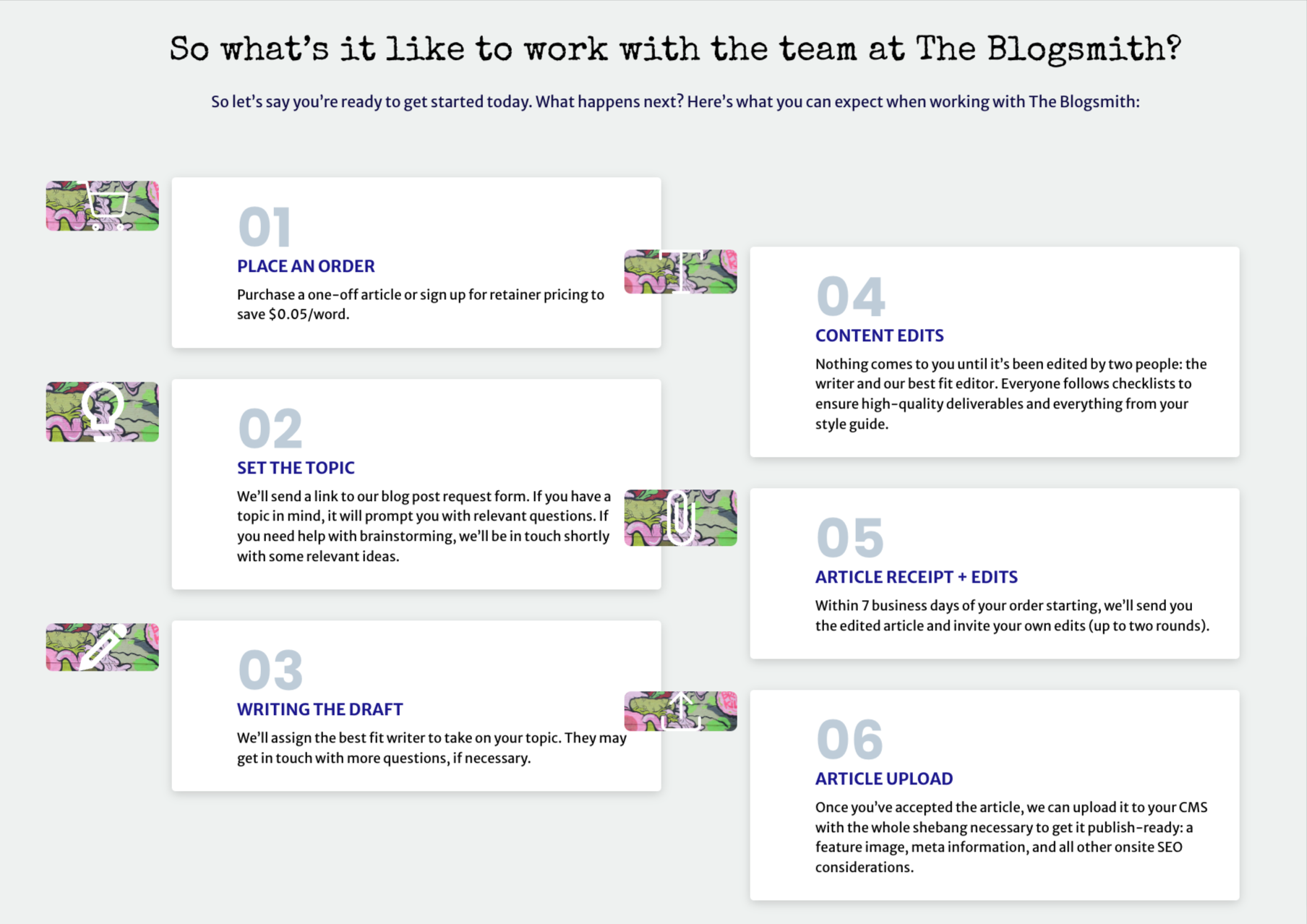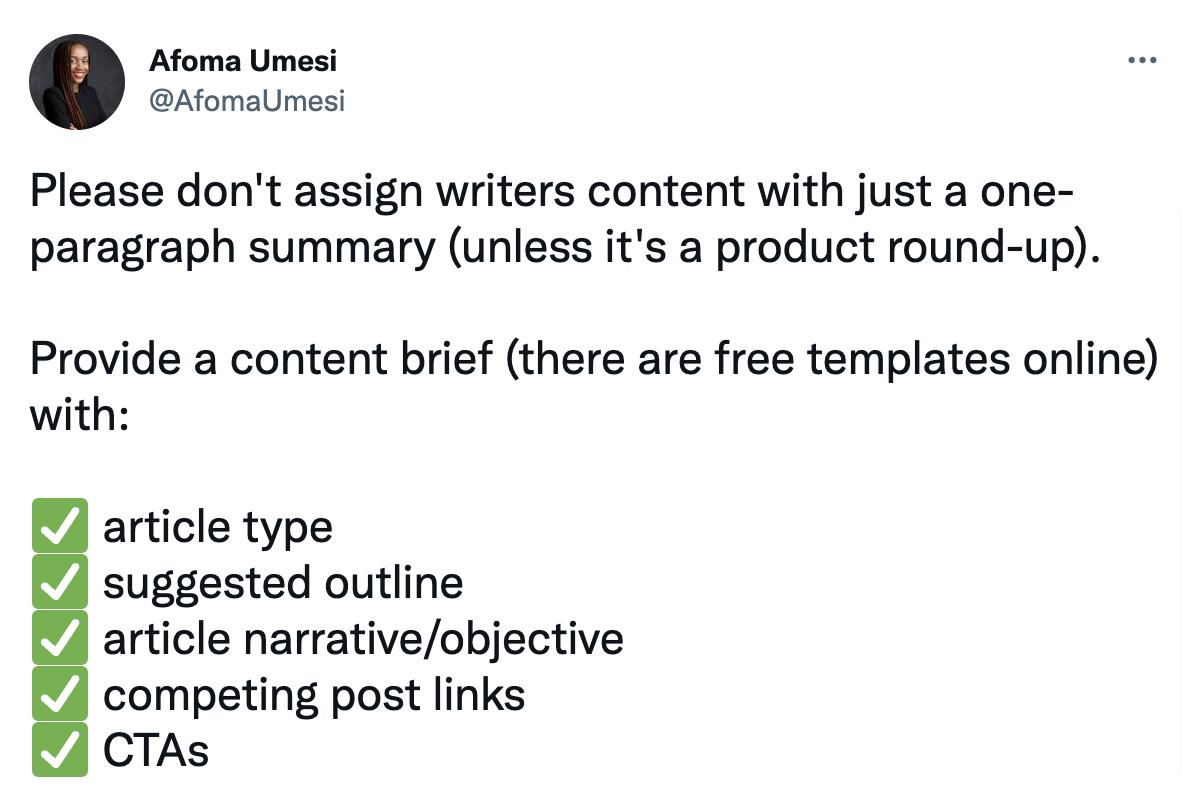8 Must-Haves In Your Content Guidelines: What Your Writers Need To Know via @sejournal, @MaddyOsman
Set your brand's writers up for success by providing detailed writing guidelines – here's how (including real-world examples). The post 8 Must-Haves In Your Content Guidelines: What Your Writers Need To Know appeared first on Search Engine Journal.

Brands often turn to freelance writers or marketing agencies to scale up content production.
But that’s not always a smooth process.
A 2021 Semrush report shares that in-house content teams face frequent issues with outsourced writers:
Lack of hands-on experience or knowledge (49%). Low-quality content (42%). Multiple edits (36%). Lack of consistency due to different writing styles (27%).These issues mean your content team has more work to do – just what you didn’t want and what made you outsource the content in the first place!
Now, you can try finding a word magician who can Abracadabra your worries away and makes everything alright.
But it doesn’t always work that way – you do run into some misguided wizards here and there.
Instead of leaving things to chance, work toward preparing content guidelines you can give the outsourced writers to minimize the challenges of working together
Content Guidelines 101
Content guidelines (or writing guidelines) refer to the information brands or their in-house content teams give their outsourced writers to produce commissioned content.
These include style guides, product information, and access to tools.
Detailed content guidelines provide several benefits:
Save time and money.
Writers may be professionals, but they can’t read your mind, especially if they’re external to your team.
By sharing the required details with them, you can reduce the revisions on both ends.
In other words, content guidelines give writers an idea and context of what you want and expect from a content piece before they start the draft.
This lets them see the target before they attempt to hit a bullseye, and you don’t have to realign the overall direction after the first draft.
Encourages consistency.
A content brief ensures both writers and editors are on the same page regarding the content style, tone, and goals.
Sets your work in the right direction: Great content is a result of collaboration between brands and writers. By providing detailed writing guidelines, you do your part and show the writers what you want from the content piece.
Helps you scale content production.
A standard set of writing guidelines lets you grow and scale the content production since you can easily onboard more writers and editors to write and edit content in your brand’s voice and tone.
So, if you provide content guidelines, your issues are gone?
No, that alone won’t cut it. Your results depend on the details you add to those content guidelines.
What To Include In Content Guidelines
Welcome packet. Editorial process. Brand style guide. Visual guidelines. Content brief. Persona details. Product information. Industry’s resources.Once again, external writers can’t read your mind.
They’re not a part of your day-to-day team meetings. In order to make up for this gap, you must provide detailed content guidelines.
1. Welcome Packet
As you start working with new writers, provide them with a welcome packet that includes all the details they need to know to create content for you, including:
Your brand and its value proposition. Your content goals. Topics you commonly write about. FAQs about working with you. People on your team the writers can reach out to for content and billing questions.Your welcome packet helps onboard new writers and set them in the right direction.
But you still need more guidelines to cover everyday details.
2. Editorial Process
The editorial process details what the writers should expect to deal with regularly – your brand’s content workflow.
It defines the expected timeline for each action after both parties have signed an agreement.
For instance, here’s how my team handles it, from the client’s perspective:
 Screenshot from TheBlogsmith.com, June 2022
Screenshot from TheBlogsmith.com, June 2022
The writing process can certainly vary case by case, but it’s good to set expectations with writers in terms of what happens before, during, and after they turn in a draft.
3. Brand Style Guide
If there is one must-have with writing guidelines you give to writers, it’s a style guide.
A style guide covers the dos and don’ts of writing for your brand. It provides direction to in-house and outsourced content teams and ensures your content is consistent with the brand ethos.
This consistency enhances the customer experience and builds customer loyalty.
After years of working as a freelance writer, I shifted to a content agency model.
One of the first things I did to set my agency up for success was create The Blogsmith Style Guide – a document that details my best practices from years of experience working with different clients.
It helps writers capture the voice and tone that The Blogsmith is known for and gives editors a straightforward standard for editing content.
A style guide covers:
Grammar (active voice vs. passive voice). Style and formatting requirements. Tone (conversational or formal). Punctuation preferences (oxford comma or not). Word usage (use of abbreviation, inclusive language, or jargon). Spelling preferences (e.g., ecommerce vs. e-commerce). Point of view or pronoun usage (first person or second person). Citations.If you don’t have a style guide, the Associated Press (AP) Stylebook serves as a good baseline.
4. Visual Guidelines
Most brands include visual guidelines within their style guide, but some like keeping them separate.
Whatever the case, visual guidelines are a must-have part of your content guidelines, as brand visuals impact the written aspect of content creation.
Not to mention, visual guidelines ensure consistent output if you outsource your graphics.
Make sure to include the following in your visual guidelines:
Image directions
Include everything writers and graphic designers need to know about creating or choosing images for your website, such as: image attribution, featured images, custom images vs. stock photos, text vs. no text in featured images.
Preferred formats
Share formats you prefer for images and videos, such as .PNG, .JPEG, or .webP.
Image resolutions and sizes
Share your preferred image resolution and file size. For instance, it’s better to limit the file size of images to 250–300 KB to load them quickly on your website and score better in Core Web Vitals.
Colors
Include the brand palette and Hex, RGB, CMYK, and Pantone color codes to account for print vs. digital (and so on). You can also include the purpose of each color (e.g., main vs. accent, headings vs. body content, and so on).
Fonts
Include the fonts you use for different purposes. For example, Kinsta uses Brandon Text for headings and Roboto for body text.
Logos and icons
Include all versions of your logos and their proper use cases.
You can share your visual guidelines on your website for freelancers and agencies to reference – like Kinsta.
 Screenshot from Kinsta.com, June 2022
Screenshot from Kinsta.com, June 2022
5. Content Brief
A content brief is a writing guide freelance writers can follow when creating a particular content piece for your company.
Compared to the other content guidelines on the list, content briefs differ in topics depending on the assignment – but they are essential to creating a stellar content piece.
 Screenshot from Twitter, June 2022
Screenshot from Twitter, June 2022
The content brief must include basic information, such as:
Client name. Topic. Word count. Article type (blog post, case study, or white paper). Rate. Due date.More detailed briefs also include additional information that gives the writer context, like:
Intended Audience
Who are you writing the content for?
Adding your intended audience is crucial, especially if you have multiple target audiences.
It informs the angle you’ll be taking.
For example, content for C-suite executives differs from content targeting entry-level employees.
While some content brief details like competitors may be reusable, intended audience and content goals may vary across pieces.
It’s best to fill out all the information regardless of whether it varies to ensure you don’t miss anything.
Content Goals And Objectives
What is the purpose of creating the content piece?
One take on the content marketing matrix suggests that content’s four main purposes are to educate, entertain, inspire, and convince.
Whatever the content goal, share that with the writer.
Being clear about your content goals and objectives also makes it easier to do keyword research, determine search intent, and develop a relevant call to action (CTA) for the post.
Also, you can add a short abstract highlighting the important points you want in the piece or provide the writer with a suggested outline.
Keyword Research
If you’re creating SEO content, include the primary keywords you’re trying to optimize for and instructions or best practices.
For example, you can ask writers to include:
Primary keyword in the title and within the first 100 words. High-volume keywords in subheadings. Low-volume keywords in paragraphs.More than often, your writer or agency will provide this. But you should still plan to review and approve it, so everyone is on the same page before drafting.
Competitors
Include competitors and top-ranking blogs to help writers benchmark content.
It lets writers observe what other brands did well and how they addressed the problem.
Not to mention, It helps them identify missing information to strategize how to make your content stand out.
6. Persona Details
Buyer personas represent the target audience at different stages of the buyer’s journey.
Including this information in your content guidelines gives writers a better picture of what your customers want and need. They can fill in gaps and tailor messaging to each persona.
If you haven’t had the chance to define your personas yet, HubSpot’s Make My Persona tool is an excellent place to start.
7. Product Information
If you’re asking freelance writers to create product-led content, give them the tools they need to succeed like:
A dummy account they can play around with and take screenshots of for tutorials. Case studies that show how customers have used your product and achieved results. Opportunities to interview SMEs (subject matter experts) about the product.In other words, the writer should know enough about the tool and the problem it solves to address customer pain points and get them to convert.
8. Industry Knowledge
For thought-leadership content, give writers access to information from industry thought leaders and SMEs.
As a courtesy, before you give writers the details of an SME they can contact, let the SME know a writer will reach out to set up an interview.
Some SMEs may be uncomfortable speaking with other people (or too busy to nail down a specific time for a live interview), so give them the option to do an interview via a meeting, an email exchange, or a prerecorded video or audio response.
Make it convenient for both parties to get the information they need.
Conclusion
Good writing is often a result of collaboration between the brand and writers.
Don’t be a client from hell. Improve the experience of working with outsourced content teams by providing writing guidelines they can use to create content closer to your goals.
More resources:
The 7 Habits of Successful Content Writers 8 Free Courses For Writers & Content Marketers Content Marketing: The Ultimate Beginner’s Guide to What WorksFeatured Image: sutadimages/Shutterstock

 Lynk
Lynk 
































